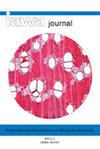Hydraulic architecture of crown in three Brazilian species
IF 3.5
3区 农林科学
Q2 FORESTRY
引用次数: 0
Abstract
The hydraulic limitation hypothesis postulates an increase in resistance to water conductivity as trees become taller. Accordingly, we expect that the hydraulic architecture of trees shares a close relationship with the crown architecture and that anatomical traits can directly or indirectly influence hydraulic conductivity. The aim of this work was to investigate the variations in vessels, hydraulic properties and wood density of three native Brazilian tree species. We selected 40-year-old Balfourodendron riedelianum, Cariniana legalis and Handroanthus vellosoi trees and measured maximum vessel length, specific hydraulic conductivity, the percentage loss of conductivity, leaf hydraulic conductivity, and density of branches at three different positions of the crown. Variability in anatomical and hydraulic properties was mostly explained by differences between species, while small differences were related to the position of the branch along the crown-position gradient. Within the measured variables, only the maximum vessel length differed between one crown position and the other. We posit that poor differences between anatomical and hydraulic positions in the crown-position gradient could be related to sample positions within the crown, which were relatively close to each other, with branches having similar ages and diameters. Our findings demonstrate that despite growing in the same environment and having the same age, our species deploy contrasting carbon allocation and hydraulic species-specific strategies. These strategies mirror different growth performances resulting from a different trade-off between hydraulic capacity and safety.三种巴西植物树冠的水力结构
水力限制假说假设,随着树木变高,对导水性的抵抗力会增加。因此,我们预计树木的水力结构与树冠结构有着密切的关系,解剖特征可以直接或间接影响水力传导率。这项工作的目的是调查三种巴西本土树种在容器、水力特性和木材密度方面的变化。我们选择了40年生的Balfourodedron riedelianum、Cariana legis和Handroanthus vellosoi树,并测量了树冠三个不同位置的最大导管长度、比导水率、导水率损失百分比、叶片导水率和枝条密度。解剖和水力特性的可变性主要由物种之间的差异来解释,而微小的差异与枝条沿树冠位置梯度的位置有关。在测量的变量中,只有一个牙冠位置和另一个位置之间的最大血管长度不同。我们认为,牙冠位置梯度中解剖位置和液压位置之间的差可能与牙冠内的样本位置有关,这些位置彼此相对接近,分支的年龄和直径相似。我们的研究结果表明,尽管生长在相同的环境中,年龄相同,但我们的物种采用了对比鲜明的碳分配和特定于水力物种的策略。这些策略反映了由于水力容量和安全性之间的不同权衡而产生的不同增长性能。
本文章由计算机程序翻译,如有差异,请以英文原文为准。
求助全文
约1分钟内获得全文
求助全文
来源期刊

IAWA Journal
农林科学-林学
CiteScore
3.40
自引率
15.80%
发文量
26
审稿时长
>36 weeks
期刊介绍:
The IAWA Journal is the only international periodical fully devoted to structure, function, identification and utilisation of wood and bark in trees, shrubs, lianas, palms, bamboo and herbs. Many papers are of a multidisciplinary nature, linking
 求助内容:
求助内容: 应助结果提醒方式:
应助结果提醒方式:


